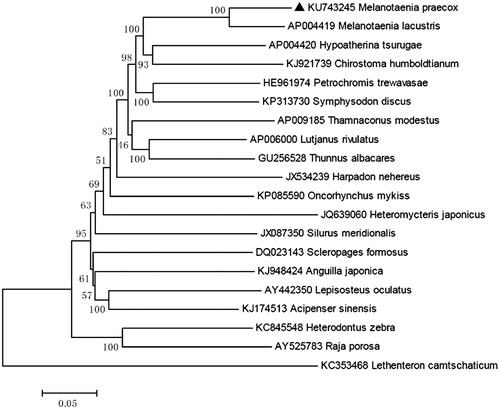Abstract
In this study, the mitochondrial genome of Melanotaenia praecox Weber and de Beaufort, 1922(Atheriniformes: Melanotaeniidae) was sequenced for the first time. The assembled mitogenome consisting of 16,536 bp, includes 13 protein-coding genes, 22 transfer RNAs, 2 ribosomal RNAs genes and 1 putative control region. The overall base composition of M. praecox is 27.51% for A, 29.97% for C, 16.18% for G, 26.34% for T and shows 89% identities to Lake Kutubu Rainbowfish, Melanotaenia lacustris. These data would provide useful molecular information for phylogenetic relationships within the family Melanotaeniidae species.
The Neon rainbowfish (Melanotaenia praecox) are bright neon blue with red dorsal, anal and caudal fins. They may reach a maximum size of 8 cm, but are usually less than 6 cm. Males have red-edged fins while the fins of females are pure yellow. Melanotaenia praecox is very similar in appearance to M. rubrivittata. The two species share a number of similarities. But M. praecox lacks the characteristic red body stripes of male M. rubrivittata. The males of M. praecox also tend to be deeper bodied than males of M. rubrivittata (Allen Citation1991).
Samples of M. praecox were wild captured from a tributary of the Mamberamo River in West Papua, then the muscle was dissected and preserved in pure alcohol. The specimens were stored in Fish Specimens Museum in Shanghai Ocean University, the accession number is SHOU20150675001. Then their genomic DNA was extracted from muscle by using Sangon Mag-MK Animal Genomic DNA extraction kit (Sangon, Shanghai, China). The primers were designed according to the complete mitochondrial genome of Melanotaenia boesemani (KT380951) deposited in GenBank. PCR amplification and sequencing of the products were performed according to the method described by He et al. (Citation2011) with slight modifications.
The complete mitochondrial genome of M. praecox was 16,536 bp in size (GenBank accession no. KU743245), including 13 protein-coding genes, 22 transfer RNAs, 2 ribosomal RNAs genes and 1 putative control region. All protein-coding genes are encoded on H-strand with exception of protein-coding genes of ND6. All tRNA genes are encoded on H-strand with exception of tRNA-Gln, tRNA-Ala, tRNA-Asn, tRNA-Cys, tRNA-Tyr, tRNA-Ser (UGA), tRNA-Glu and tRNA-Pro. All the 13 mitochondrial protein-coding genes share the start codon ATG, except for COI (GTG start codon). The stop codon, TAA, is present in COI, ND4L and ND5; TAG is present in ND1, ATP8, ND6 and Cytb; an incomplete stop codon ‘‘TA–’’ is found in ND2, ATP6 and COIII; and ‘‘T– –’’ is found in COII, ND3 and ND4. The longest one is ND5 gene (1839 bp) in all protein-coding genes, whereas the shortest is ATP8 gene (168 bp). The size of the 22 tRNA ranges from 66 bp to 74 bp. The two ribosomal RNA genes, 12S rRNA gene (946 bp) and 16S rRNA gene (1679 bp), are located between tRNA-Phe and tRNA-Leu (UAA) and separated by tRNA-Val.
The control region, which is 880 bp, is located between tRNA-Pro and tRNA-Phe. The overall base composition of M. praecox is 27.51% for A, 29.97% for C, 16.18% for G, 26.34% for T, which is characteristic of mitochondrial genomes of other bony fish (Miya et al. Citation2003; Zhao et al. Citation2015a,Citationb), and shows 89% identities to Lake Kutubu Rainbowfish, M. lacustris (). We expect that the present result would elucidate the further phylogenetic approach among different species of rainbowfishes.
Disclosure statement
This work was supported by a grant from Shanghai Collaborative Innovation Center for Aquatic Animal Genetics and Breeding (ZF1206). The authors report no conflict of interest. The authors alone are responsible for the content and writing of the paper.
References
- Allen GR. 1991. Field guide to the freshwater fishes of New Guinea. Madang, Papua New Guinea: Christensen Research Institute.
- He A, Luo Y, Yang H, Liu L, Li S, Wang C. 2011. Complete mitochondrial DNA sequences of the Nile tilapia (Oreochromis niloticus) and Blue tilapia (Oreochromis aureus): genome characterization and phylogeny applications. Mol Biol Rep. 38:2015–2021.
- Miya M, Takeshima H, Endo H, Ishiguro NB, Inoue JG, Mukai T, Satoh TP, Yamaguchi M, Kawaguchi A, Mabuchi K, et al. 2003. Major patterns of higher teleostean phylogenies: a new perspective based on 100 complete mitochondrial DNA sequences. Mol Phylogenet Evol. 26:121–138.
- Zhao Y, Chen Z, Gao J, Wang L, Li Z. 2015a. The complete mitochondrial genome of boeseman's rainbowfish (Melanotaenia boesemani Allen & Cross, 1980). Mitochondrial DNA. 2015:1–2. DOI:10.3109/19401736.2015.1089556
- Zhao Y, Chen Z, Gao J, Wang L, Li Z, Yu Y, Zhou Q. 2015b. The complete mitochondrial genome of red rainbowfish (Glossolepis incises Weber 1907). Mitochondrial DNA. 2015:1–2. DOI:10.3109/19401736.2015.1079882

